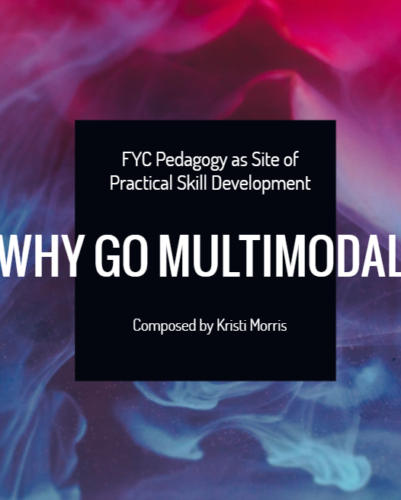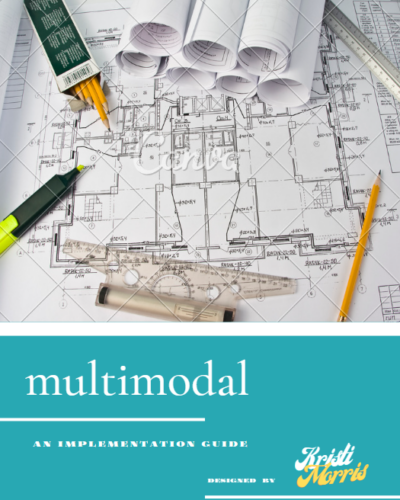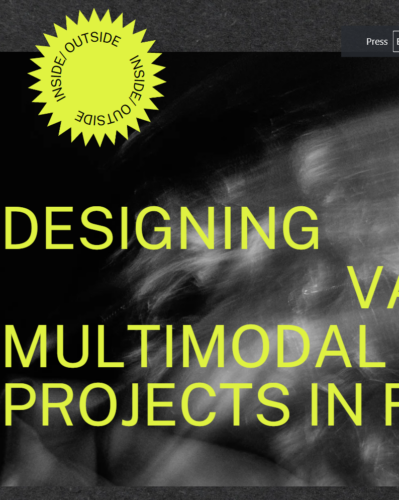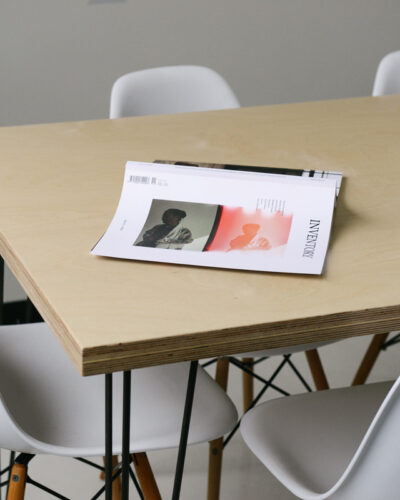Focusing into Design and Blurring Out Traditional Writing: A Mixed-Method Student-Centered Study of Multimodal Composition
the shape of the Dissertation
DesigningFYC.com fulfills my requirement to earn a doctoral degree in Rhetoric and Writing Studies. Instead of moving through doctoral coursework and determining a focus that appealed to me enough to explore in a dissertation, I had a strong idea about what I wanted to do from my very first class. I had forever been interested in visual rhetoric and the ways that we communicate through image, sound, and word. Although I began dissertation work in the traditional vein of academic writing – dry, predictable and focused on the product- I found it to the benefit of my audience to zhuzh it up with questions left unanswered, less structure and reimagining what my dissertation could be. This new, unconventional vein demanded that I make the project more about how my approach to teaching affects FYC students. This choice was not made out of arrogance or self-indulgence but instead to illustrate the result when I aligned the identity, voice, and passion of the students with my own. It captures meaningful work that students created during the course- projects that asked powerful questions and pushed students to challenge both their assumptions, their audiences, and their assumptions about their audiences. Although the numerous features of the website force apart one cohesive story, both of the student case studies attest to the design-focused work central to the course.
Viewers can begin to see a picture emerge- one that shows the value of multimodal composition and the development of intentional writers. DesigningFYC.com is by no means groundbreaking. I would never claim to be a digital writing expert either- hell, building this site would have been much easier for one of my primary school-aged children- ya know, “digital natives.” Regardless, here you and I are, and I am excited for you to take a stroll through what it looks like to take a Design-Focused Approach to First-Year Writing.
the shape of the argument
I developed a first-year writing curriculum that analogized the writing process with that of designing in order to emphasize the recursive quality of composing- a sort of series of making and remaking. Most importantly, this curriculum granted students agency to make EVERY decision in their respective projects so that their writing was situated in and responsive to a unique rhetorical situation.
This Design-Focused Approach or DFA became a unique chance for my First-Year student’s composing processes to be creative, iterative and valuable. To show how the composing process itself could be meaningful, but also how what they made became A meaningful thing. This demonstrated to students the kind of authenticity and relevance their writing could have despite generating from an academic space – (which was a concept explored in the Meaningful Writing Project by Eodice, Lerner and Geller from 2016). Effectually, the artifacts my students produced could have exigence in contexts beyond the university setting. Composing, framed as designing, allowed for students to engage their target audience in a multisensory experience that strengthened the thing’s situatedness, responsiveness and reflectiveness in regard to the identity of the writer. It allowed students to assert their voices into larger conversations by adding their perspectives and proposals.
In this dissertation project, I take the position that the exploration of modal affordances MUST BE foundational to the First-Year writing course as students are expected to employ multiliterate skills that allow them to participate in larger conservations. The case studies and anecdotal evidence resulting from my dissertation research, expands on existing knowledge in the field of composition studies by adding qualitative data that examines the effectiveness of a Design-Focused approach to FYC. I hypothesize that modeling the similarities among the processes (constructing, designing, writing, and making of a thing) evident in the arts and humanities will show students the value of writing by inherent problem-solving-whether it be in the rhetorical aspects of design or the content of the project- but hopefully BOTH!
Lesson excerpt to show parallels between writing & designing
In order to guide students through such productive work, I implemented a process-based method where they maintained Design Journals throughout each project. most importantly, the journal method was aligned with the learning outcomes of the course. the objective of the course, per the course’s designation as part of the General Education sequence, intended for students to gain an understanding of reading, writing and researching. the department of English states that:
The main goals of the course are (1) to teach students to consider the rhetorical situation of any piece of writing; (2) to have students integrate reading, research, and writing in the academic genres of analysis and argument; and (3) to teach Students to develop analyses and arguments using research-based content, effective organization, and appropriate expression and mechanics. To achieve these goals, the course places considerable emphasis upon the relationship between reading and writing, the development and evaluation of information and ideas through research, the genres of analysis and argumentation, and the use of multiple technologies for research and writing.
Thus, I was challenged to develop a course that did the work expected of the department and university- but satisfied my nagging sense that there were more meaningful and generative opportunities for students to explore through their projects. Although the text-based prompts provided to students were quite clear, I did not adapt the discourse of design (define, ideate, plan, prototype, test, and improve) in each Design Journal. Instead, I chose to use commonplace terms that students would recognize and understand immediately. I did not want to layer another set of terms to decode, when oftentimes it is difficult for students to absorb the primary discourse of writing studies used in the Introduction to College Writing course- terms like ethos, exigence, and affordance. I decided I would organically weave in the work of design without the specific language associated with design. Rather than say “ideate,” I suggested that students “share sources of inspiration…[and] conceive of this as a mood board” to do this work.
Here, on the site, the 6 steps of the Design Process are the roots for the entire course design. The Design Journals (1-5) were numbered in a sequence that repeated with each project. The Design Journals moved students carefully through identifying a problem to its solution by mimicking what designers would typically perform.
Engineers, graphic designers, authors, architects and artists are each confronted with problems or issues that they seek to resolve (Shipka, 2011). Although the work that they do may not always “translate” or be successful, their work is NONETHELESS contributing to an ultimate solution. I thought about the work of Flower & Hayes who asserted that the cognitive process used to write or make something is the same, but the rhetorical situation changes according to the modal affordance. Deliberately analogizing the processes- constructing, designing, writing, and making- creates a space for students to apply what they already know, as well as what they will come to know, in relevant ways.
audio capture 1
I learned that students, in a DFA to FYC, were actively engaged with their work on very personal levels and worked the design process steps to responsibly interrogate the important problems and issues surrounding them. Instead of Current-Traditional rhetoric, whereby students attempt to meet the rigid expectations of academic genres, multimodal pedagogy necessitates a student-centered approach that creates unlimited ways student’s work can be relevant and agential (Marback,2009). It relieves the emphasis placed on the product and rather on to the meaningful labor of the process. Proving the purpose and relevance of many of the genres repeatedly assigned to students in FYC courses is difficult for writing instructors- when will students be asked to write the same products beyond the university? The objective, of the FYC course, should be to facilitate the critical thinking and rhetorical awareness expected for students to be multiliterate in professional, civic and social spaces. Although a design approach creates with the user in mind, it still requires the writer/designer to participate in what becomes an exchange of ideas, needs, and impact. Scaffolding the writing process through Design Journals and Project Builders, in a DFA to FYC, was a viable strategy to teach rhetorical agency, flexibility, agency and revision. Students researched their projects, not merely to build content knowledge, but to examine how the writers shaped the artifact; in turn, the students examined rhetorical situations in ways they had never had an opportunity before.
Our digital reality and image-driven environment is in a perpetual state of change with advanced platforms, tools, and software introduced to us every day. Students are expected to be multiliterate to consume and produce in these complex spaces. This reality impacts the way FYC is taught; more specifically, that writing instructors be flexible to respond to student needs. I have concluded through my work in this project that embracing multimodal pedagogy through a Design-Focused Approach to First-Year Composition is positioned well to do this work. The approach supports students in a recursive and thoughtful process for generating ideas and meaningful projects.
a relevant argument
Most recently, the media has been all consumed (practically devoured) by the feud between music powerhouses Kendrick Lamar and Drake. Their rap beef cannot and should not be reduced to a mere pop culture moment as it exemplifies the power of a medium. Although musicians and lyricists by trade, Kendrick and Drake’s current situation has put a spotlight on how sign systems transmit ideas. From releasing “diss tracks” aimed at taking shots at one another to their respective music videos- tightly packed with allusions and cultural references- these artists are giving a masterclass in multimodal writing and designing. Each artist has tediously crafted a message, whether it be in words, beats, or images, to create an effect on their audiences. They present an argument in each of the 10 tracks to date (July 11, 2024). They make assertions and double-down by providing often harsh, but poignant evidence
AND
this is where I find further evidence for implementing a multimodal pedagogy in FYC. Kendrick and Drake use their art to exchange important ideas and participate in larger conversations. Their music is a vehicle for self-expression, but it is bigger than just putting themselves out in the world for display. They have succeeded in getting audiences that are watching and listening (regardless of if intentionally or not) to reflect on America’s social and political realities: racism, capitalism, sexual violence, and the cult of celebrity.
Beyond Kendrick and Drake’s fans, the phenomenon has extended to Baby Boomers and Generation X- peppering their everyday conversations at the dinner table. What this tells me is that FYC students, as the next wave of thinkers and contributors, are tasked with the responsibility to properly consume such cultural messages. They certainly have a lot to learn from them. I am a writing instructor, by trade, so I will leave music theory to the other department, but what
I WILL BE
doing is teaching FYC students how to be multiliterate. My DFA will support students in their understanding of the rhetorical situation for any number of cultural artifacts- from songs trending on Spotify to Black Lives Matter button pins to Open Letters written by activists. It matters not that the students are not famous, that they have not yet staked their claim in an industry. It does matter that they feel empowered and inspired to join the conversations that surround them. A multimodal pedagogy for the FYC will create this reality for students. They can practice relevant, responsible ad purposeful writing by creating artifacts like Tik Toks, responding to Twitter threads, and recording podcasts to of course give their perspective on all the Easter eggs in Kendrick’s “Not Like Us” music video (among other things).
iterative shapes of my argument
The dissertation project has gone through 3 distinct iterations.
Iteration 1
Initially, I developed a slide-based presentation on Visme that interrogated the stated purpose of FYC courses as general education requirements for many post-secondary institutions against what they actually do according to their curricular goals and objectives (shown below as Iteration 1). The 1st iteration began a journey that worked on 2 things- the modality of the project and the various points to support my claim- foremost being that multimodal composing was not emphasized in or central to the assignment sequence of FYC curricula. The presentation also shows my efforts in trying a new mode of delivery: aural. I recorded segments of me speaking instead of writing through my ideas. In retrospect, I recognize my inclination to practice talking through my thoughts and working out problems, which in later iterations become intentional reflections (audio process captures) of my rhetorical decision-making for each aspect of the project.
iteration 2
The 2nd iteration was also slide-based, but the presentation was a scrolling format on Canva instead of using a click through function. I would characterize this next prototype as a more thoughtful approach for the project to ultimately become a fully functioning guide to multimodality. I was interested in designing a learning platform that would include modules tailored specifically for instructors to learn how to more intentionally implement multimodality into their FYC classroom. although this 2nd presentation did not include actual learning modules for users, it did dive more deeply into the many aspects necessary to fully understand the development of FYC curricula. I was deliberate about gathering together all things multimodal in order to provide post-secondary instructors with the materials they would need to be confident to perform this work.
iteration 3
Although the 3rd iteration of the project was still a Canva presentation, the scope changed significantly. This prototype was not a distinct iteration of the dissertation project as a whole, but narrowed down to a specific research question that would map the argument with the use of anecdotal evidence to answer the question. When I asked- how do students recognize both immediate meaning and long-term value in design-focused approaches to their composing praxis- I was testing the effectiveness of the curricular approach that I developed for FYC. In the 1st project iteration, I discovered a great deal of tension between FYC and institutional values that blurred the purpose and usefulness of academic writing for students. In this 3rd iteration, I employed qualitative data to illustrate the student perspective. The case study used throughout the presentation validates that a DFA prioritizes student agency, especially in the student’s power to make all rhetorical decisions in their work. It proves that student work is positioned to be meaningful and poignant to them.
and now…
Here, on the site, I have redesigned previous iterations and project segments to pivot on the student work. With hope, writing instructors can imagine how to scaffold tasks that work toward similar goals. Of course, I have still included the lessons and activities that I wrote into my curriculum- but I aim to inspire and generate new and exciting means to get at the same ends.

kristi morris
the instructor

How do I think about my scholarship?
Thinking on how to answer such a question reminds me of the interview situation. How intently must I show my academic knowledge? How many scholars or theories should I reference? It just seems forced and inauthentic. Although I recognize the need for such knowledge, if nothing else but to propel the field forward and toward new theories and praxis, I still find myself wanting to talk through my thoughts, my responses, my own take on writing. I’m neither claiming to be the expert, nor am I dismissing the pivotal work that came before me. Instead, my work is not scholarship focused on numbers, studies, or reports, but on my investment in listening to students. I watch them. I read their work. I eavesdrop on their group conversations. Then, I go back to the drawing board- adjusting lesson plans to meet their needs, especially to make their tasks relevant for their disciplines. I suppose that this makes me an anthropologist of sorts-documenting my observations and trying to learn something from it.
How am I contributing to scholarship?
This site has become a documentation of a long journey: teaching, talking, analyzing, designing, and reflecting. Although it does not assume the structure of a dissertation, it evidences an awareness of what the artifact is expected to perform.
What is the endgame of the site?
I’m committed to seeing this project through long term. Much like developing a dissertation into a book, I have hopes that this site will reach a broader audience. I envision the site as a sort of repository for multimodal work samples, instructional lessons, video tutorials and commentaries. DesigningFYC.com will have an open access membership feature to provide a space for instructors to BOTH gather and contribute ideas, but also for students to celebrate their work by sharing it on a public platform AND appreciating what they can learn from one another.





